Operators
 Sweden
Sweden
| HE 3 | |
|---|---|
| Role | Sports plane |
| National origin | Germany |
| Manufacturer | Heinkel |
| First flight | 1923 |
The Heinkel HE 3 was a sports aircraft built in Germany in the early 1920s. It was a conventional, low-wing monoplane with seating for three people in two tandem cockpits. The wing was a cantilever design, an unusual and advanced feature for the day. The fixed undercarriage was designed to be quickly changed from wheeled tailskid type to twin pontoons for operation as a seaplane. A HE 3 won first prize in its class at the 1923 aero meet at Gothenburg, and was subsequently selected as a trainer by the Swedish Navy, which bought two examples. In Swedish service, the aircraft gained the nickname Paddan ("Toad").
The HE 3 had fabric-covered wooden wings, and a plywood-covered wooden fuselage.
General characteristics
Performance

The PZL TS-8 Bies is a Polish trainer aircraft, used from 1957 to the 1970s by the Polish Air Force and civilian aviation.

The Aero Letňany A.10 was a biplane airliner produced in Czechoslovakia shortly after World War I. It was the first commercial aircraft to be built in Czechoslovakia and was known as the Ae-10 Limousine. It was designed by Husnik and Vlasak and was intended to meet the growing need for aerial communication to and from the country. Behind the single nose-mounted engine was a cabin with seats for three and two tables, upholstered on the underside, and able to be inverted to provide another two seats if required. A double skinned firewall between the engine and cabin, together with double skinned surfaces to the walls, floor and roof and Triplex windows gave a (relatively) quiet ride. A rear window gave communication with the pilot, whose open cockpit was above and behind the cabin. The cockpit also accommodated the navigator who had a seat directly behind the pilot.
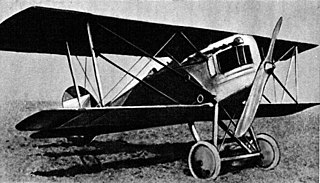
The Aero A.18 was a biplane fighter aircraft built in Czechoslovakia in the 1920s. It was a development of the Ae 02 and Ae 04 fighters Aero had designed during World War I, but also borrowed from the more recent A.11 reconnaissance-bomber design.

The RWD-10 was a Polish aerobatics sports plane, single-seat parasol wing monoplane, used from 1933 to 1939 and constructed by the RWD team.
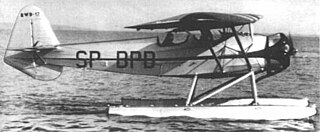
The RWD 17 was a Polish aerobatics-trainer aircraft of 1937, parasol wing monoplane, constructed by the RWD team.

The Boeing Model 15 was a United States single-seat open-cockpit biplane fighter aircraft of the 1920s, manufactured by the Boeing company. The Model 15 saw service with the United States Army Air Service and with the United States Navy as a carrier-based fighter.

The Boeing XF6B-1 / XBFB-1 was Boeing's last biplane design for the United States Navy. Only the one prototype, Model 236, was ever built; although first flying in early 1933, it rammed into a crash barrier in 1936 and the design was not pursued further.
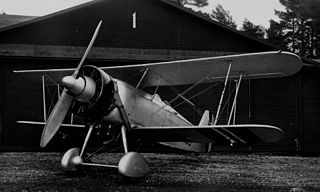
Svenska Aero Jaktfalken ("Gyrfalcon") was a Swedish biplane fighter aircraft, constructed in the late 1920s. The aircraft was first manufactured by Svenska Aero and later by AB Svenska Järnvägsverkstädernas Aeroplanavdelning (ASJA).

The LVG C.VI was a German two-seat reconnaissance and artillery spotting aircraft used during World War I.

The Mudry CAP 10 is a two-seat training aerobatic aircraft first built in 1970 and still in production in 2007. The plane was developed from the Piel Super Emeraude and was born as the CP100. The name changed to CAP 10, CAP for 'Constructions Aéronautiques Parisiennes'. The CAP 10 was manufactured by Mudry in Bernay, France, bought by CAP Industries which then became Apex Aircraft. Following the bankruptcy of Apex in 2008, rights to produce spares were awarded to Dyn'Aviation. After the bankruptcy of DynAero in 2012, manufacture of spares was taken over by CEAPR in Darois.

The Heinkel HE 5, produced in Sweden as the Svenska S 5 and nicknamed the "Hansa", was a reconnaissance floatplane built during the 1920s. It was a further development of the HE 1, sharing its same basic configuration as a low-wing, strut-braced monoplane. The HE designation also refers to the monoplane construction, standing for Heinkel Eindecker.

The Heinkel HD 24 was a training seaplane developed in Germany in the late 1920s. It was a conventional single-bay biplane with equal-span, staggered wings. The fuselage was braced to both the upper and lower wings with a number of struts on its sides, in addition to the normal cabane struts. The pilot and instructor sat in tandem, open cockpits, and the undercarriage consisted of twin pontoons, although this could be readily exchanged for wheels or skis.

The Lioré et Olivier LéO H-13 was a French biplane two-engine flying boat of the 1920s, built in passenger and military variants.
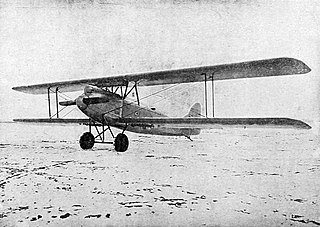
The Letov Š-6 was a bomber aircraft produced in Czechoslovakia during the 1920s. Derived from the Š-2, it was a biplane of conventional design. The wing cellule was an all-new design with a thicker profile, and while it had been intended to build them with a metal structure, wood was used instead due to shortages. Performance during testing was so promising that in 1924 an Š-6 was used to set a new altitude record with a 500 kg payload, and a national endurance record of 10 h 32 min.
The Slingsby T.25 Gull 4 is a British glider designed and built by Slingsby that first flew in 1947.

The Fisher FP-202 Koala is a Canadian single-seat high wing, conventional landing gear, single engined light kit aircraft designed for construction by amateur builders. The aircraft was inspired by the design of the Piper J-3 Cub and strongly resembles that design.

The Bellanca CF is an early enclosed high-wing monoplane designed by Giuseppe Mario Bellanca that led to a successful series of Bellanca aircraft. Bellanca was nominated for the Collier Trophy in 1922 for the CF design.
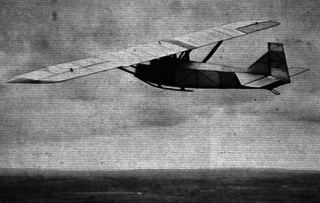
The 1926 German RRG Prüfling of 1926 was a secondary training glider designed for club use. Plans were sold and it was built in Germany and across the world.

The FVM J 23 was a Swedish single seat, single engine, parasol wing fighter aircraft built in the mid-1920s. Five were flown but the type never reached operational status because of structural concerns raised by a fatal accident.
The Heinkel HD 19 W was a biplane seaplane fighter developed by Ernst Heinkel Flugzeugwerke.